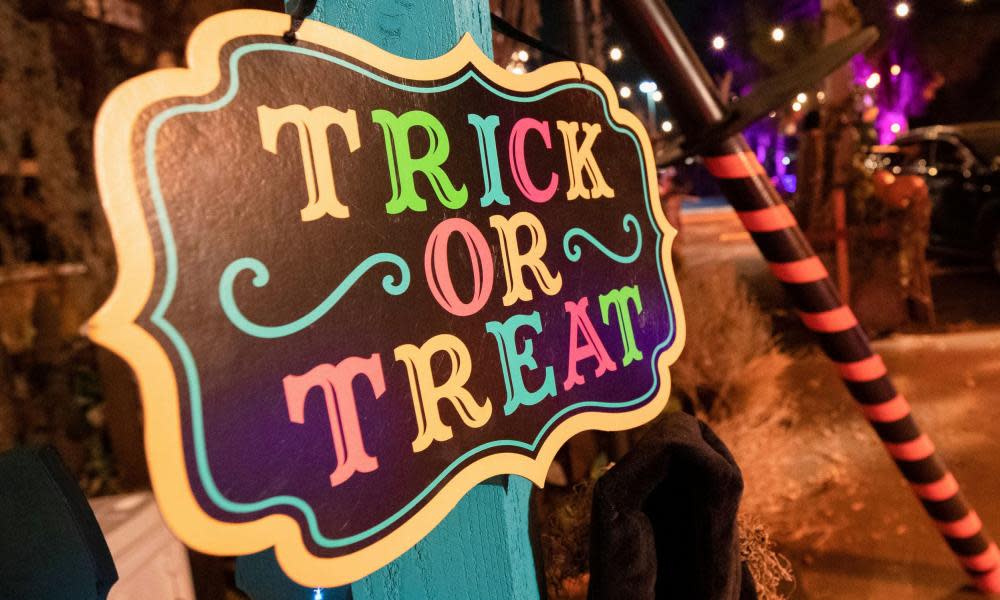Spooky films and scare trails: how to have a Covid-safe Halloween

It’s that time of year many children have been dreaming about for months, planning costumes and nasty surprises for their neighbours. Although some politicians have hinted that Halloween may be cancelled this year, Guardian readers have been sharing their plans, which include spooky film screenings, “scare trails” and outdoor scavenger hunts. And scientists say there are ways of celebrating spooky season, while still staying safe.
“I think there’s of lots of things you can do which are really low risk, like carving pumpkins and putting them outside, making costumes, decorating the house and putting lights in the windows – all within your own household,” said Linda Bauld, professor of public health at the University of Edinburgh.
Related: The last-chance saloon: Glaswegians contemplate 16 days with no pubs
Trick or treating is more risky, since children often crowd around doorsteps in groups, or step inside porches – all of which should be avoided. If you must go trick or treating, do it in groups of two or three, including a parent, Bauld said.
Another spooktacular strategy is to pre-specify which houses you will be visiting, having checked with the occupants first. “Avoid houses where there are vulnerable adults and there should be no cold-calling,” advised Prof Azeem Majeed, professor of primary care and public health at Imperial College London. “Do not go indoors. And if your doorbell rings, avoid answering to people or groups who cold call.”
Trick or treating raises other issues as well. Although the chances of contracting coronavirus from surfaces is thought to be lower than scientists assumed at the start of the pandemic, there may still be a risk from pushing doorbells or plunging unwashed hands into buckets of sweets.
Getting close enough to hand out sweets is also ill-advised, so some Guardian readers are planning to leave treats outside their homes instead: “I will be staying inside my front porch in my vampire costume to greet people from behind glass doors, and outside on a trestle table will be my homemade mock pumpkin pie and millionaire shortbread squares,” said a reader from Cheshire, who wished to remain anonymous.
Pre-wrapping treats is another way of reducing the risk of transmission
– but you should wash your hands first – and face masks are essential.
“Even though they’re outdoors I think it would also be good idea for children to wear masks, if only to remind them that this is not normal, and there is a risk in what they’re doing,” said Prof Sally Bloomfield, a consultant in hygiene and infectious disease prevention and honorary professor at the London School of Hygiene and Tropical Medicine. She would prefer people to avoid trick or treating this year. “There’s a barrel-load of social contact that we can dip into, and I think you’ve got to choose which things are really important; so is trick or treating really important?”
Many Guardian readers say the risks are too great, and they are planning to forego trick or treating this year. Some say they are planning small parties for friends or family instead, but Prof Bauld warns this could be even worse. “Going outside on a trail or trick or treating in a small group is far less risky than any kind of house party,” she said.
Small outdoor gatherings, socially distanced costume parades and spooky garden scavenger hunts all get the green light, however. Elinor Kirk, from Fife, is planning to decorate her garden and create a window display with skeletons, witches and a pumpkin. “I will be wearing my Dark Fairy outfit and my creepy playlist will provide suitable songs like The Monster Mash and The Time Warp,” she says. “I hope we will be visited by the boys from next door who can join in dancing, dooking for apples and eating treacle scones, but if we can’t have visitors, my husband and I will dance and dook on our own.”


